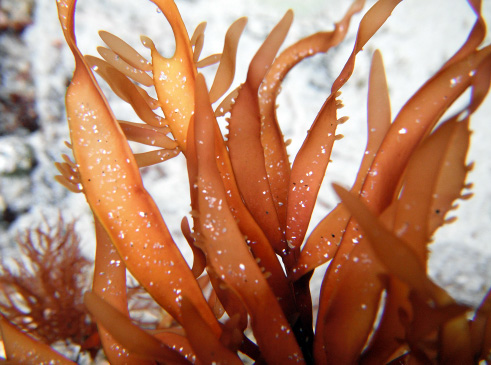Narrow iodine seaweed, narrow bleach weed, bleachweed • Grateloupia americana, Prionitis lanceolata
Identification
This red alga is highly variable in both colour and morphology. It ranges from red to red-brown to reddish-purple and is often tinged with yellow, especially during the summer. The body of the alga (the thallus), which is supported by a small disc-shaped holdfast, is composed of irregularly forked, flattened branches that form a cluster of elongated, tapered, and often curling blades. The edges of the branching blades are lined with small projections. Narrow iodine seaweed grows 20-80 cm in length. The colour, size, and degree of branching vary with habitat.
Habitat & Range
Narrow iodine seaweed can be found growing on rocks and in tidepools in the intertidal and subtidal; where it occurs in intertidal and subtidal habitats has a large impact on its morphology. Its range extends from southern Alaska to Baja California, Mexico.
Intriguing Info
A nitrogen deficiency causes the yellow tinge that may be observed in this species; it is more prevalent in summer as nitrates in the surrounding surface water are in short supply. Both narrow iodine seaweed and bleachweed species — such P. sterbergii — smell of bleach when crushed.
This red alga is highly variable in both colour and morphology. It ranges from red to red-brown to reddish-purple and is often tinged with yellow, especially during the summer. The body of the alga (the thallus), which is supported by a small disc-shaped holdfast, is composed of irregularly forked, flattened branches that form a cluster of elongated, tapered, and often curling blades. The edges of the branching blades are lined with small projections. Narrow iodine seaweed grows 20-80 cm in length. The colour, size, and degree of branching vary with habitat.
Habitat & Range
Narrow iodine seaweed can be found growing on rocks and in tidepools in the intertidal and subtidal; where it occurs in intertidal and subtidal habitats has a large impact on its morphology. Its range extends from southern Alaska to Baja California, Mexico.
Intriguing Info
A nitrogen deficiency causes the yellow tinge that may be observed in this species; it is more prevalent in summer as nitrates in the surrounding surface water are in short supply. Both narrow iodine seaweed and bleachweed species — such P. sterbergii — smell of bleach when crushed.
References
Chiu, A. (2003). Prionitis lanceolata. Marine Botany. Monterey Bay Aquarium Research Institute. Accessed 23/01/2015.
Lamb, A., and Hanby, B. (2005). Marine Life of the Pacific Northwest [electronic version]. Madeira Park, BC: Harbour Publishing.
O'Clair, R. and Lindstrom, S. Grateloupia americana Kawaguchi et Wang. In Klinkenberg, Brian. (Ed.). E-Flora BC: Electronic Atlas of the Plants of British Columbia. Lab for Advanced Spatial Analysis, Department of Geography, University of British Columbia, Vancouver. Accessed 23/01/2015.
Authors and editors of page
Kelly Fretwell and Brian Starzomski (2015).
Chiu, A. (2003). Prionitis lanceolata. Marine Botany. Monterey Bay Aquarium Research Institute. Accessed 23/01/2015.
Lamb, A., and Hanby, B. (2005). Marine Life of the Pacific Northwest [electronic version]. Madeira Park, BC: Harbour Publishing.
O'Clair, R. and Lindstrom, S. Grateloupia americana Kawaguchi et Wang. In Klinkenberg, Brian. (Ed.). E-Flora BC: Electronic Atlas of the Plants of British Columbia. Lab for Advanced Spatial Analysis, Department of Geography, University of British Columbia, Vancouver. Accessed 23/01/2015.
Authors and editors of page
Kelly Fretwell and Brian Starzomski (2015).






